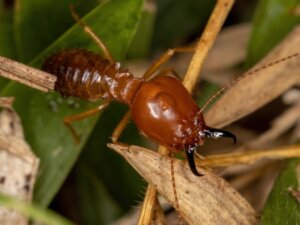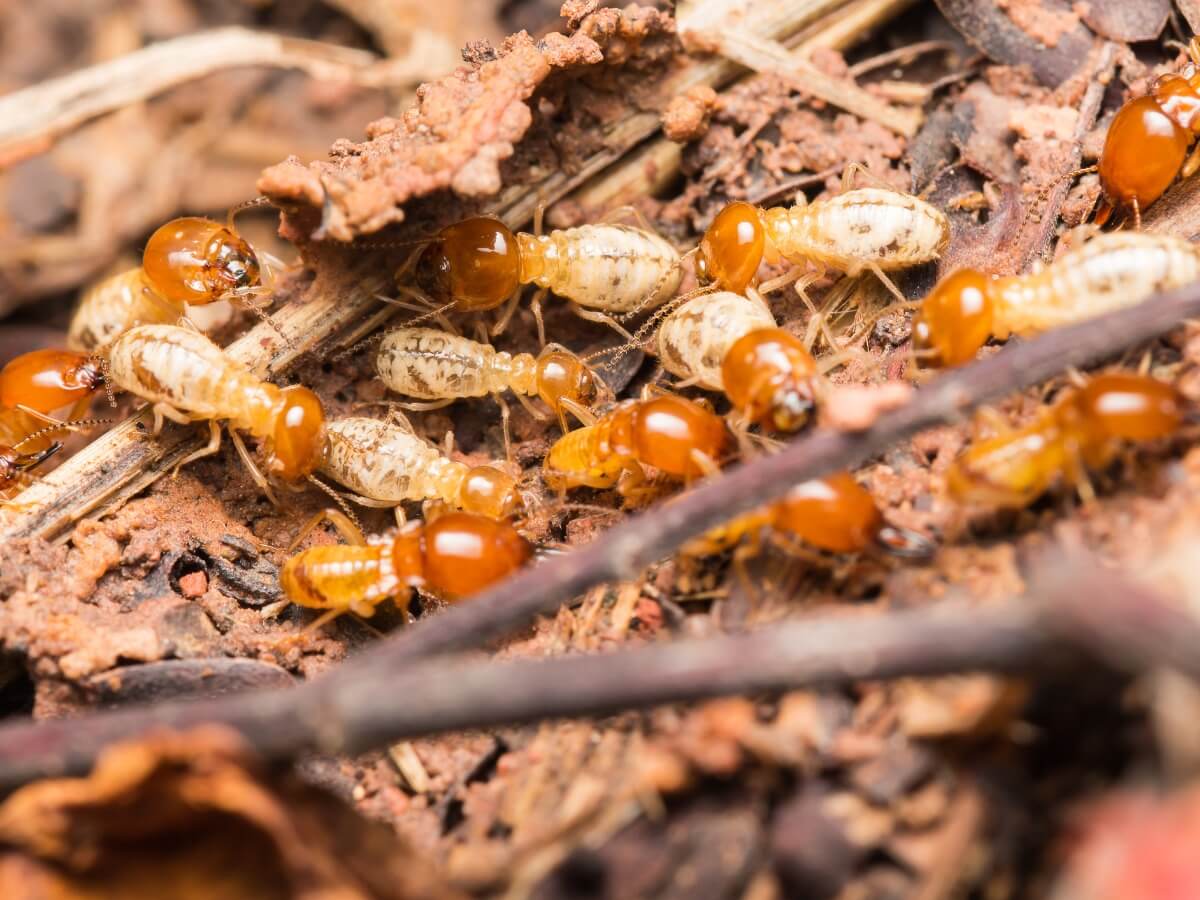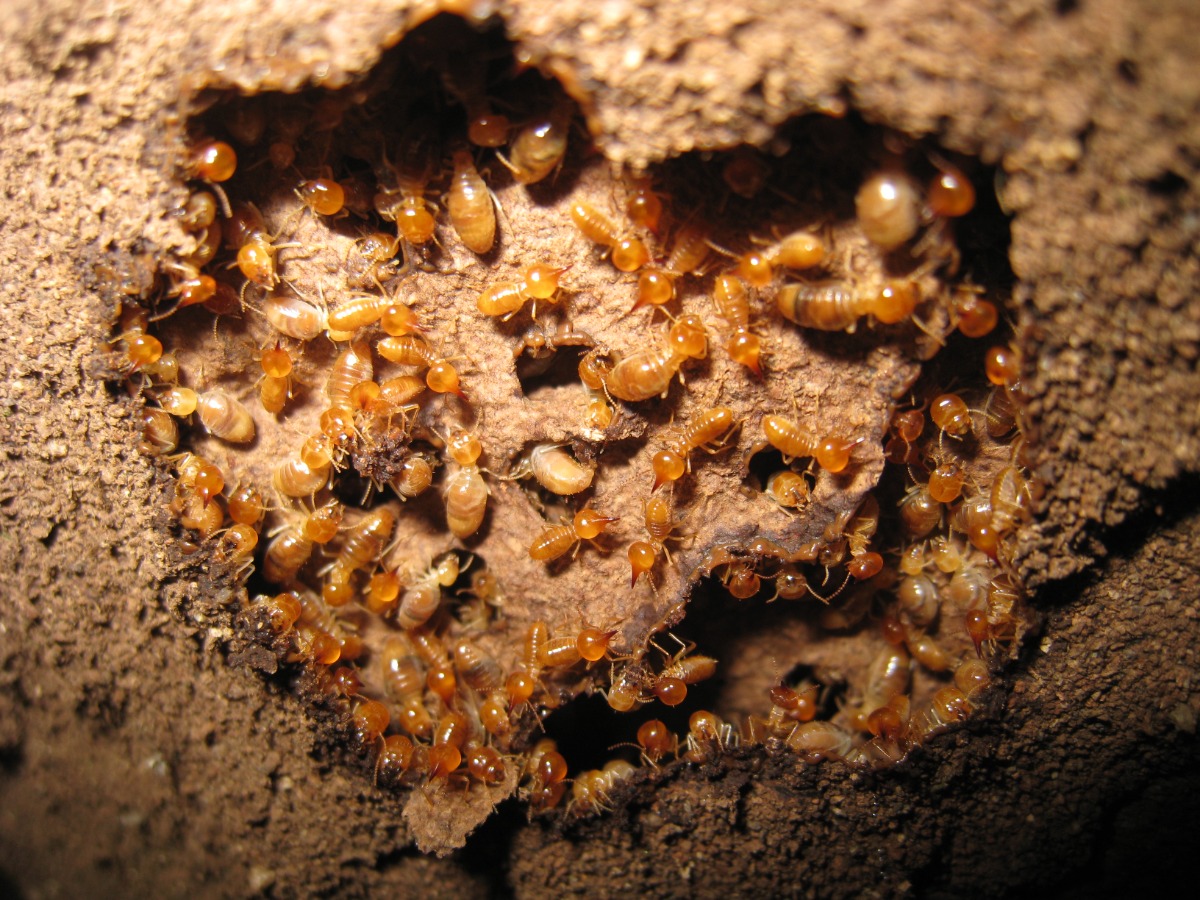10 Curiosities About Termites


Written and verified by the biologist Samuel Sanchez
There are many curiosities about termites, but unfortunately many people don’t want to know anything about them! While it’s true that they cause real damage to architecture, these small insects have many biological traits unique to their group that make them very special.
Termites form huge colonies, organize themselves into castes, and digest food that other living things are unable to assimilate. Would you like to know more about them? Here we’ll show you 10 curiosities about termites, their biological makeup, and their ecology. Don’t miss them!
1. Termites are relatives of cockroaches
Before talking about their social organization, we need to specify the taxonomic status of these invertebrates. Termites belong to the class Insecta (with beetles, grasshoppers, and more) and to the lower group of the order Blattodea. This means that, at a genetic level, they’re very close relatives of domestic cockroaches.
In turn, termites form their own lower group, the Isoptera suborder. Some 3,000 species have been described within this taxon, but there are almost certainly many more. More than 1000 of these species are located in Africa, where the mounds and underground galleries are a common feature of the landscape.
Termites are direct relatives of cockroaches and have evolved from them.
2. Termites are not ants
Termites are often mistaken for ants because of their colonial character and small size, but they aren’t close relatives. The group of insects that concerns us here is whitish in color, doesn’t have eyes and has a much flatter and thicker body plane than that of a typical ant.
The body of these animals is divided into the same segments as all insects: prothorax, mesothorax and metathorax. Each of these 3 sections has a pair of legs and protective plates, called tergites in the dorsal plane and sternites in the ventral plane. The last segment of the metathorax (abdomen) is characterized by the presence of a pair of ridges.
Worker termites never have wings, but breeding males and females are winged for a short time.

3. All termites are small, right?
Termites are associated with very small sizes, as on average they measure from 0.4 to 1.5 centimeters. However, there are certain exceptions to this rule: the queen of the Macrotermes bellicosus species can measure to 10 centimeters in length, while its workers rarely exceed 0.36 centimeters. The breed determines its size.
4. Curiosities about termites: the queens of eusociality
Despite not being direct relatives, termites share a clear eusocial organization system with bees and ants. This means that the population is divided into castes according to their morphology and they work in the group. In the termite mound, we find the following representatives:
- Workers: These are in charge of looking for food, storing it, building the nest, taking care of the larvae, and feeding the queen. It seems that the less experienced workers spend their time protecting their queen, while the more experienced go outside to forage.
- Soldiers: Their only task is to protect the colony. They have obvious jaws and large heads and, due to their anatomy, are sometimes unable to feed on their own. The workers take care of them.
- Queen and King: These stay together for life and the queen constantly lays eggs.
In eusocial organisms, the biological structure is much greater than the sum of its parts. The workers and soldiers are sterile and only one pair reproduces.
5. A different eusociality
As you can see, the social structure is quite different from that of ants. With ants, the winged males live for a very short time and their only task is to reproduce. For this reason, as soon as they impregnate a winged female on the nuptial flights, they die. In termites, this isn’t the case, since the king and queen remain together for life.
This change is also reflected at a genetic level. Male ants are haploid (n), which means that they have half the genetic information and hatch from unfertilized eggs. In termites, this isn’t the case, since the kings are the product of sexual reproduction and have the same amount of DNA as the rest of the members of the colony.
https://www.youtube.com/watch?v=Xc8GBSOKs2E
6. The workers have more “personality”
Within anthills, all the workers are female and behave in the same way. In termite mounds, this isn’t the case, as there are male and female workers that can have different roles within the colony. However, their color is always pale yellowish and they’re smaller and more fragile than the king and queen.
Beyond ecological distinctions, both insects have things in common. As studies indicate, the presence of wings in kings and queens before founding the colony in the two families indicates a clear evolutionary convergence. It’s also curious that, in both groups, the workers have adapted to digging underground and, therefore, have lost the ability to have wings.
7. Colonies of astronomical numbers
One of the most shocking curiosities of termites is that they live in gigantic societies. Earth “skyscrapers” are famous in countries like Africa and indicate the building capacity of these insects. A single colony can consist of 60,000 to 1,000,000 workers, depending on the species and environmental conditions.
A termite “megacity” has been recorded in Brazil, covering 230,000 square kilometers, the size of Great Britain.
8. The basis of the ecosystem
Termites are detritivore organisms that are responsible for metabolizing plant organic matter at any level of decomposition. Interestingly, they’re considered one of the main biological factories of atmospheric methane (11%), as they release it during the cellulose degradation process. In order to digest this complex plant compound, they require the help of certain microorganisms.
One of the most fascinating curiosities about termites is that they harbor protozoa and protists in their digestive system. These are responsible for producing the enzymes necessary to degrade cellulose, and in return, they receive a suitable medium for their survival. It’s a clear example of symbiosis, as both parties win.
More “evolved” species can produce the enzyme cellulase and break down cellulose, but they still rely on bacteria to do most of the work.
9. The young aren’t born with their symbiote mechanism
Another of the curiosities of termites is that the young don’t come into the world with the enzyme-producing microorganisms in their digestive system. Therefore, they must feed on the waste of adult specimens and then obtain it for themselves as soon as their ability to digest cellulose is developed.

10. A conflictive relationship with the human being
Lastly, it should be noted that the relationship of certain species of termites with humans is highly conflictive. In the United States alone, these insects cause a loss of 5,000 billion dollars each year, as they install themselves in the partitions and wooden furniture of homes and buildings and can cause very serious damage.
Although these insects are just following their instincts, sometimes it’s necessary to kill them because of their condition as a pest. In any case, the debate remains open: are we the ones who are occupying their ecosystems, causing them to take advantage of human constructions?
There are many curiosities about termites, but unfortunately many people don’t want to know anything about them! While it’s true that they cause real damage to architecture, these small insects have many biological traits unique to their group that make them very special.
Termites form huge colonies, organize themselves into castes, and digest food that other living things are unable to assimilate. Would you like to know more about them? Here we’ll show you 10 curiosities about termites, their biological makeup, and their ecology. Don’t miss them!
1. Termites are relatives of cockroaches
Before talking about their social organization, we need to specify the taxonomic status of these invertebrates. Termites belong to the class Insecta (with beetles, grasshoppers, and more) and to the lower group of the order Blattodea. This means that, at a genetic level, they’re very close relatives of domestic cockroaches.
In turn, termites form their own lower group, the Isoptera suborder. Some 3,000 species have been described within this taxon, but there are almost certainly many more. More than 1000 of these species are located in Africa, where the mounds and underground galleries are a common feature of the landscape.
Termites are direct relatives of cockroaches and have evolved from them.
2. Termites are not ants
Termites are often mistaken for ants because of their colonial character and small size, but they aren’t close relatives. The group of insects that concerns us here is whitish in color, doesn’t have eyes and has a much flatter and thicker body plane than that of a typical ant.
The body of these animals is divided into the same segments as all insects: prothorax, mesothorax and metathorax. Each of these 3 sections has a pair of legs and protective plates, called tergites in the dorsal plane and sternites in the ventral plane. The last segment of the metathorax (abdomen) is characterized by the presence of a pair of ridges.
Worker termites never have wings, but breeding males and females are winged for a short time.

3. All termites are small, right?
Termites are associated with very small sizes, as on average they measure from 0.4 to 1.5 centimeters. However, there are certain exceptions to this rule: the queen of the Macrotermes bellicosus species can measure to 10 centimeters in length, while its workers rarely exceed 0.36 centimeters. The breed determines its size.
4. Curiosities about termites: the queens of eusociality
Despite not being direct relatives, termites share a clear eusocial organization system with bees and ants. This means that the population is divided into castes according to their morphology and they work in the group. In the termite mound, we find the following representatives:
- Workers: These are in charge of looking for food, storing it, building the nest, taking care of the larvae, and feeding the queen. It seems that the less experienced workers spend their time protecting their queen, while the more experienced go outside to forage.
- Soldiers: Their only task is to protect the colony. They have obvious jaws and large heads and, due to their anatomy, are sometimes unable to feed on their own. The workers take care of them.
- Queen and King: These stay together for life and the queen constantly lays eggs.
In eusocial organisms, the biological structure is much greater than the sum of its parts. The workers and soldiers are sterile and only one pair reproduces.
5. A different eusociality
As you can see, the social structure is quite different from that of ants. With ants, the winged males live for a very short time and their only task is to reproduce. For this reason, as soon as they impregnate a winged female on the nuptial flights, they die. In termites, this isn’t the case, since the king and queen remain together for life.
This change is also reflected at a genetic level. Male ants are haploid (n), which means that they have half the genetic information and hatch from unfertilized eggs. In termites, this isn’t the case, since the kings are the product of sexual reproduction and have the same amount of DNA as the rest of the members of the colony.
https://www.youtube.com/watch?v=Xc8GBSOKs2E
6. The workers have more “personality”
Within anthills, all the workers are female and behave in the same way. In termite mounds, this isn’t the case, as there are male and female workers that can have different roles within the colony. However, their color is always pale yellowish and they’re smaller and more fragile than the king and queen.
Beyond ecological distinctions, both insects have things in common. As studies indicate, the presence of wings in kings and queens before founding the colony in the two families indicates a clear evolutionary convergence. It’s also curious that, in both groups, the workers have adapted to digging underground and, therefore, have lost the ability to have wings.
7. Colonies of astronomical numbers
One of the most shocking curiosities of termites is that they live in gigantic societies. Earth “skyscrapers” are famous in countries like Africa and indicate the building capacity of these insects. A single colony can consist of 60,000 to 1,000,000 workers, depending on the species and environmental conditions.
A termite “megacity” has been recorded in Brazil, covering 230,000 square kilometers, the size of Great Britain.
8. The basis of the ecosystem
Termites are detritivore organisms that are responsible for metabolizing plant organic matter at any level of decomposition. Interestingly, they’re considered one of the main biological factories of atmospheric methane (11%), as they release it during the cellulose degradation process. In order to digest this complex plant compound, they require the help of certain microorganisms.
One of the most fascinating curiosities about termites is that they harbor protozoa and protists in their digestive system. These are responsible for producing the enzymes necessary to degrade cellulose, and in return, they receive a suitable medium for their survival. It’s a clear example of symbiosis, as both parties win.
More “evolved” species can produce the enzyme cellulase and break down cellulose, but they still rely on bacteria to do most of the work.
9. The young aren’t born with their symbiote mechanism
Another of the curiosities of termites is that the young don’t come into the world with the enzyme-producing microorganisms in their digestive system. Therefore, they must feed on the waste of adult specimens and then obtain it for themselves as soon as their ability to digest cellulose is developed.

10. A conflictive relationship with the human being
Lastly, it should be noted that the relationship of certain species of termites with humans is highly conflictive. In the United States alone, these insects cause a loss of 5,000 billion dollars each year, as they install themselves in the partitions and wooden furniture of homes and buildings and can cause very serious damage.
Although these insects are just following their instincts, sometimes it’s necessary to kill them because of their condition as a pest. In any case, the debate remains open: are we the ones who are occupying their ecosystems, causing them to take advantage of human constructions?
All cited sources were thoroughly reviewed by our team to ensure their quality, reliability, currency, and validity. The bibliography of this article was considered reliable and of academic or scientific accuracy.
- Bourguignon, T., Lo, N., Dietrich, C., Šobotník, J., Sidek, S., Roisin, Y., … & Evans, T. A. (2018). Rampant host switching shaped the termite gut microbiome. Current biology, 28(4), 649-654.
- Maurice, N., & Erdei, L. (2018). Termite gut microbiome. In Termites and Sustainable Management (pp. 69-99). Springer, Cham.
- Nishimura, Y., Otagiri, M., Yuki, M., Shimizu, M., Inoue, J. I., Moriya, S., & Ohkuma, M. (2020). Division of functional roles for termite gut protists revealed by single-cell transcriptomes. The ISME Journal, 14(10), 2449-2460.
- Snyder, T. E. (1926). The biology of the termite castes. The Quarterly Review of Biology, 1(4), 522-552.
This text is provided for informational purposes only and does not replace consultation with a professional. If in doubt, consult your specialist.








